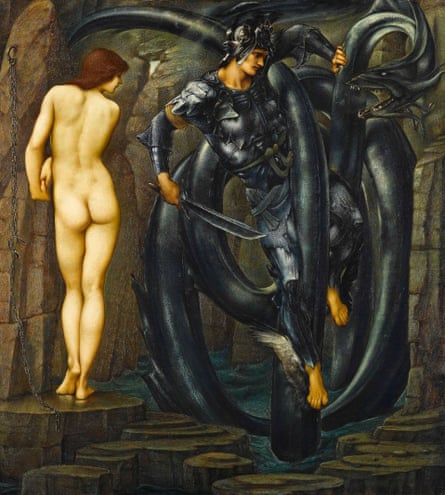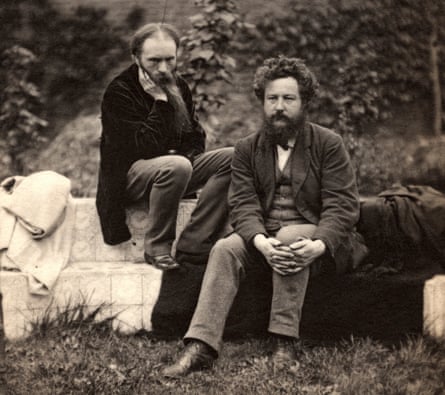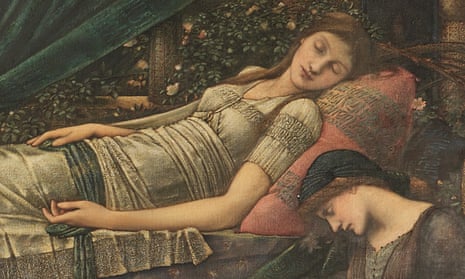Halfway through Tate Britain’s loving homage to the Victorian “visionary” Edward Burne-Jones I was startled to see a painting I gave a damn about. It’s a portrait of William Graham, colonial businessman, Liberal MP and art collector. His emaciated, sick-looking face stares straight at you from a small dark canvas. Two mad sweeps of white hair sprout from either side of his balding crown. His eyes are gelid and numbed. He looks utterly tortured.
Why is this small, unpretentious portrait so much more interesting than the depictions of mythology and legend that fill this exhibition? Because it looks real. Graham was Burne-Jones’s patron and there must have been true intimacy between them. For once, Burne-Jones paints with a raw simplicity that gives you the awkward and irreplacable sense of being confronted by life, not art.
Almost everything else in the exhibition is art that disdains life. Burne-Jones was one of the last artists to adopt the archaic style of the pre-Raphaelite movement that started in 1848, when he was 15. The pre-Raphaelites preached a return to the craft ethos of medieval art, a flame Burne-Jones would keep burning up to the eve of the 20th century. After embracing the style of Dante Gabriel Rossetti when he was in his 20s, he carried on ploughing the same dreamy furrow until his death in 1898. What he added to the pre-Raphaelite love of long-haired beauties and Arthurian poesy was an ideal of art for art’s sake that makes his paintings strangely dessicated.

For his enthusiasts, this makes him a forebear of modern art whose dream paintings have a lot in common with European symbolists such as Munch and Moreau, and point the way to pure abstraction. The quintessential illustration of that is Burne-Jones’s 1880 painting The Golden Stairs. A procession of maidens in long blue-grey dresses make their way in a serpentine parade down a spiralling staircase. They seem to belong nowhere except this moment, this cold and lovely otherworld that is Art – even though actual women, including the daughter of prime minister William Gladstone, modelled for this fey concoction.
There is a twisted line that connects The Golden Stairs with modernism, for in 1912 Marcel Duchamp would echo it in his machine-like flutter of repeated movements Nude Descending a Staircase No 2. But Duchamp was a prankster mixing up the latest Cubist style with a hokey Victorian sentimentalisation of beauty. He was joking, guys. It doesn’t make Burne-Jones the inventor of modern art.
By the end of this exhibition I felt like one of the women trapped for ever on that staircase, going round in circles, seeing endless versions of the same idea. Burne-Jones was a contemporary of Darwin but evolution passed him by. It’s not only the aesthetic universe he paints that is immobile in time. His own talent shows no sign here of ever going anywhere new or unexpected.

His first paintings are as mature as he will ever get. Cupid’s Forge dates from 1861, just a few years after he abandoned a degree at Oxford – where he met his lifelong influence William Morris – to become an artist. Two youthful figures kneel in a vaguely erotic yet mysteriously passive encounter in a woodland. The boy has wings, so this must be the world of myth. It may seem assured for an artist in his late 20s but it gets a lot less impressive as you go from room to room and find him repeating the same coolly sexualised yet celibate bodies, the same pastoral settings, the same frozen narratives.
In a massive series of paintings of the Greek hero Perseus, done more than two decades later, the thinness of the repertoire is impossible to ignore. Great artists who have painted Greek mythology use all their powers to make it real and immediate. Think of Caravaggio’s sublime painting of Medusa’s severed head swarming with snakes. The head of Medusa appears several times in Burne-Jones’s Perseus cycle, too, but it never looks the least bit scary. That’s because he goes out of his way to reassure us this is not a real world. It is Art.
That was the philosophy of the aesthetic movement. Today, this late Victorian cultural movement can be seen as radical, but Burne-Jones shows its dreary side. His art reeks of sterile cultured conversations in tasteful drawing rooms. In fact, the really great minds of the aesthetic movement were intensely aware of the potential fatuousness of art for art’s sake. What Burne-Jones needed, apart from a slap in the face with a wet fish, was to read more Oscar Wilde. For Wilde there’s always tension between ideal and reality, art and life. That’s the meaning of his artistic horror story The Picture of Dorian Gray.
To put it bluntly, Burne-Jones is a stupid artist. That is very striking in this exhibition’s recreation of an entire room that he decorated with scenes from the story of Sleeping Beauty. These paintings of briar roses and sleeping knights are all detail and no thought, a steam engine romantic’s prose masquerading as poetry.
The most laughable revelation of his faults comes at the end of the exhibition with his supposed masterpiece of book illustration, the Kelmscott Chaucer. Produced with Morris and published in 1896, this ornate tome is a lovely artefact – but wait a minute. This is an edition of Chaucer: a smirking, dirty realist who told stories of medieval hanky panky and satirised pomposity and hypocrisy. Burne-Jones absorbs him into the same numbed daydream he’d been drawing and painting for four decades. See what I mean? Stupid. Burne-Jones proves how boring beauty can be.
Edward Burne-Jones is at Tate Britain, London, from 24 October until 24 February.

Comments (…)
Sign in or create your Guardian account to join the discussion